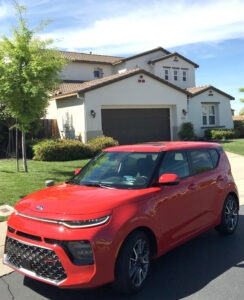Among the innovative boxy vehicles that were introduced around a decade ago, only one survivor remains – the Kia Soul.
We bid farewell to the Honda Element, Nissan Cube and Scion xB, but the Soul has not only survived, it has thrived. Often identified for its “toaster-shaped” look, the Soul has been a huge success. Kia has sold more than a million Souls since its 2009 debut.

The 2020 Kia Soul is capable of carrying five passengers and is a fun commuter car that can do fine on longer trips where freeway driving and passing situations are prevalent.
Sales of the Kia Soul have exceeded 100,000 or more the past eight years and peaked at 147,133 in 2015. However, the numbers have gradually dipped with sales at 104,709 in 2018, it’s lowest total since 2011.
Coincidence or not, the third generation 2020 Kia Soul went through a total redesign. Frankly, we don’t feel the changes are all that dramatic, and predictably the Soul’s trademark look remains intact. However, there are exterior changes, including narrower headlights that span the entire length of the vehicle, a rounded nose that makes it a little sleeker, and vertical taillights that wrap around the rear window.
Despite an additional 2.2 inches of length and 1.2 inch longer wheelbase, the new Soul delivers only a modest cargo increase and doesn’t provide any more seating room. But that’s no big deal because cabin space has always been a Soul attribute.
We are still not sure how to properly classify the subcompact crossover Kia Soul – is it a wagon, hatchback or sport utility vehicle? Appearance is still what first comes to mind with the Soul, most commonly classified a four-door hatchback or SUV. It remains unique and continues to attract youthful car buyers who want something “different” and can buy it at a reasonable price.
The Soul is capable of carrying five passengers and is a fun commuter car that can do fine on longer trips where freeway driving and passing situations are prevalent. The Soul is fairly agile and can handle itself quite well on challenging, winding roads. The steering and braking capability will leave the driver with a good amount of confidence in all driving situations.
Performance has improved in the 2020 model. The base engine is a 2.0-liter, inline-four that generates 147 horsepower and 132 pound-feet of torque. It replaces last year’s weak entry-level 1.6-liter engine. Acceleration of the new Soul is modest, going 0-60 mph in 8.0 seconds.
For a much more performance-laden Soul, the GT-Line Turbo model is the choice. It features a turbocharged 1.6-liter, four-cylinder that delivers 201 horsepower. A drawback is there’s no all-wheel drive available.
2020 Kia Soul
- Performance: 2.0-liter, four-cylinder, 147 horsepower; turbocharged 1.6-liter, four-cylinder, 201 horsepower
- Mileage estimate: 27-33 mpg; 27-32 mpg
- Estimated price: $17,600 to $27,600
- Warranty: 5 years/60,000 miles; drivetrain: 10 years/100,000 miles; roadside assistance: 5 years/60,000; corrosion: 5 years/100,000
Comfort is an area that gets little criticism. There is solid head and leg room for all passengers, two qualities that are appreciated on a long trip. The Soul interior has a lot of plastic, but elbow rests and other areas that people regularly touch are softer. The interior has a nice infotainment center with a 7.0-inch color touchscreen that’s fairly easy to master. Apple CarPlay and Android Auto are standard features.
The cargo area is tall and wide, providing more room that a majority of other small SUVs. The storage area is 24.2 cubic feet and expands to 62.1 with second row folded down.
Thanks to its appealing price and a distinctive boxy exterior that’s survived the test of time, the latest edition of the Soul should again hit six figures in sales.
Weidel on Wheels is featured periodically on www.tahoeskiworld.com. Auto writer Jeffrey Weidel can be reached at [email protected]. Follow him on Twitter at @jeffweidel.